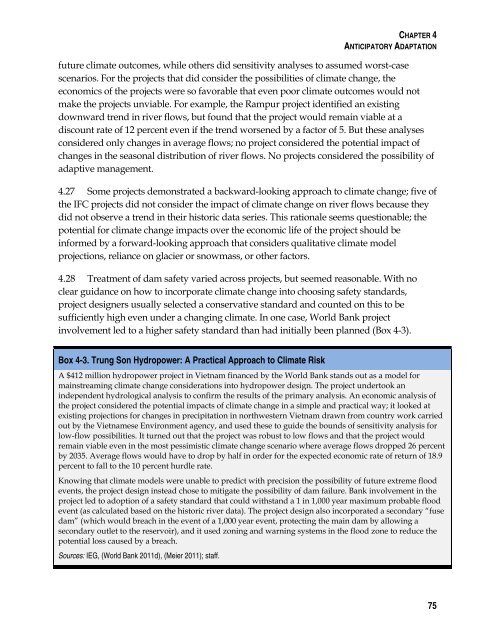Adapting to Climate Change: Assessing the World Bank Group ...
Adapting to Climate Change: Assessing the World Bank Group ...
Adapting to Climate Change: Assessing the World Bank Group ...
You also want an ePaper? Increase the reach of your titles
YUMPU automatically turns print PDFs into web optimized ePapers that Google loves.
CHAPTER 4ANTICIPATORY ADAPTATIONfuture climate outcomes, while o<strong>the</strong>rs did sensitivity analyses <strong>to</strong> assumed worst-casescenarios. For <strong>the</strong> projects that did consider <strong>the</strong> possibilities of climate change, <strong>the</strong>economics of <strong>the</strong> projects were so favorable that even poor climate outcomes would notmake <strong>the</strong> projects unviable. For example, <strong>the</strong> Rampur project identified an existingdownward trend in river flows, but found that <strong>the</strong> project would remain viable at adiscount rate of 12 percent even if <strong>the</strong> trend worsened by a fac<strong>to</strong>r of 5. But <strong>the</strong>se analysesconsidered only changes in average flows; no project considered <strong>the</strong> potential impact ofchanges in <strong>the</strong> seasonal distribution of river flows. No projects considered <strong>the</strong> possibility ofadaptive management.4.27 Some projects demonstrated a backward-looking approach <strong>to</strong> climate change; five of<strong>the</strong> IFC projects did not consider <strong>the</strong> impact of climate change on river flows because <strong>the</strong>ydid not observe a trend in <strong>the</strong>ir his<strong>to</strong>ric data series. This rationale seems questionable; <strong>the</strong>potential for climate change impacts over <strong>the</strong> economic life of <strong>the</strong> project should beinformed by a forward-looking approach that considers qualitative climate modelprojections, reliance on glacier or snowmass, or o<strong>the</strong>r fac<strong>to</strong>rs.4.28 Treatment of dam safety varied across projects, but seemed reasonable. With noclear guidance on how <strong>to</strong> incorporate climate change in<strong>to</strong> choosing safety standards,project designers usually selected a conservative standard and counted on this <strong>to</strong> besufficiently high even under a changing climate. In one case, <strong>World</strong> <strong>Bank</strong> projectinvolvement led <strong>to</strong> a higher safety standard than had initially been planned (Box 4-3).Box 4-3. Trung Son Hydropower: A Practical Approach <strong>to</strong> <strong>Climate</strong> RiskA $412 million hydropower project in Vietnam financed by <strong>the</strong> <strong>World</strong> <strong>Bank</strong> stands out as a model formainstreaming climate change considerations in<strong>to</strong> hydropower design. The project under<strong>to</strong>ok anindependent hydrological analysis <strong>to</strong> confirm <strong>the</strong> results of <strong>the</strong> primary analysis. An economic analysis of<strong>the</strong> project considered <strong>the</strong> potential impacts of climate change in a simple and practical way; it looked atexisting projections for changes in precipitation in northwestern Vietnam drawn from country work carriedout by <strong>the</strong> Vietnamese Environment agency, and used <strong>the</strong>se <strong>to</strong> guide <strong>the</strong> bounds of sensitivity analysis forlow-flow possibilities. It turned out that <strong>the</strong> project was robust <strong>to</strong> low flows and that <strong>the</strong> project wouldremain viable even in <strong>the</strong> most pessimistic climate change scenario where average flows dropped 26 percentby 2035. Average flows would have <strong>to</strong> drop by half in order for <strong>the</strong> expected economic rate of return of 18.9percent <strong>to</strong> fall <strong>to</strong> <strong>the</strong> 10 percent hurdle rate.Knowing that climate models were unable <strong>to</strong> predict with precision <strong>the</strong> possibility of future extreme floodevents, <strong>the</strong> project design instead chose <strong>to</strong> mitigate <strong>the</strong> possibility of dam failure. <strong>Bank</strong> involvement in <strong>the</strong>project led <strong>to</strong> adoption of a safety standard that could withstand a 1 in 1,000 year maximum probable floodevent (as calculated based on <strong>the</strong> his<strong>to</strong>ric river data). The project design also incorporated a secondary “fusedam” (which would breach in <strong>the</strong> event of a 1,000 year event, protecting <strong>the</strong> main dam by allowing asecondary outlet <strong>to</strong> <strong>the</strong> reservoir), and it used zoning and warning systems in <strong>the</strong> flood zone <strong>to</strong> reduce <strong>the</strong>potential loss caused by a breach.Sources: IEG, (<strong>World</strong> <strong>Bank</strong> 2011d), (Meier 2011); staff.75

















